2016 PEUGEOT 5008 ECO mode
[x] Cancel search: ECO modePage 108 of 364
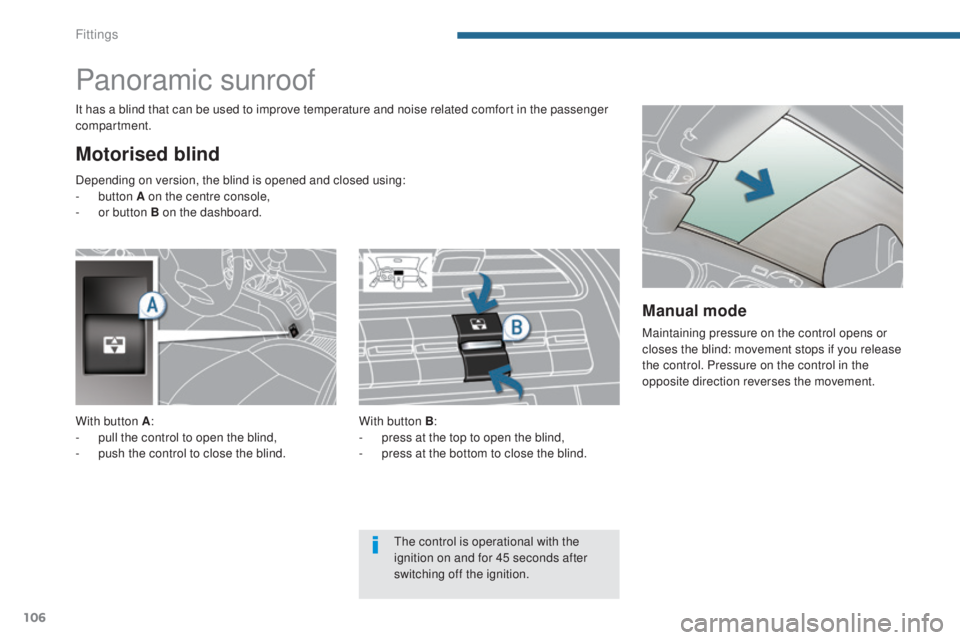
106
5008_en_Chap05_amenagements_ed01-2015
Panoramic sunroof
Motorised blind
It has a blind that can be used to improve temperature and noise related comfort in the passenger
compartment.With button B:
-
p
ress at the top to open the blind,
-
p
ress at the bottom to close the blind.
With button A
:
-
p
ull the control to open the blind,
-
p
ush the control to close the blind.
Depending on version, the blind is opened and closed using:
-
button A on the centre console,
-
o
r button B on the dashboard.
Manual mode
Maintaining pressure on the control opens or
closes the blind: movement stops if you release
the control. Pressure on the control in the
opposite direction reverses the movement.
The control is operational with the
ignition on and for 45 seconds after
switching off the ignition.
Fittings
Page 109 of 364
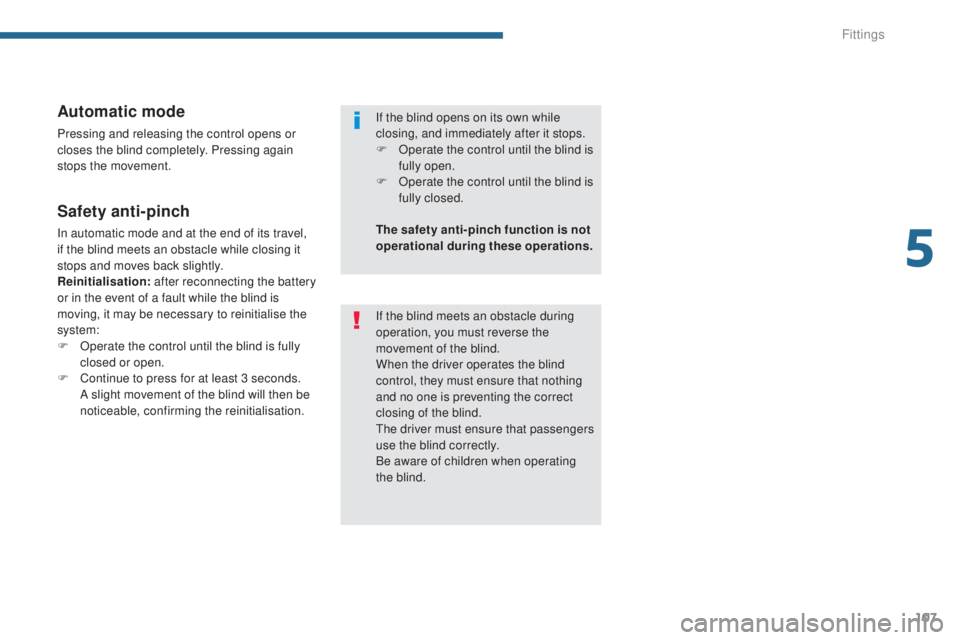
107
5008_en_Chap05_amenagements_ed01-2015
Automatic mode
Pressing and releasing the control opens or
closes the blind completely. Pressing again
stops the movement.
Safety anti-pinch
In automatic mode and at the end of its travel,
if the blind meets an obstacle while closing it
stops and moves back slightly.
Reinitialisation: after reconnecting the battery
or in the event of a fault while the blind is
moving, it may be necessary to reinitialise the
system:
F
O
perate the control until the blind is fully
closed or open.
F
C
ontinue to press for at least 3 seconds.
A slight movement of the blind will then be
noticeable, confirming the reinitialisation. If the blind opens on its own while
closing, and immediately after it stops.
F
O
perate the control until the blind is
fully open.
F
O
perate the control until the blind is
fully closed.
The safety anti-pinch function is not
operational during these operations.
If the blind meets an obstacle during
operation, you must reverse the
movement of the blind.
When the driver operates the blind
control, they must ensure that nothing
and no one is preventing the correct
closing of the blind.
The driver must ensure that passengers
use the blind correctly.
Be aware of children when operating
the blind.
5
Fittings
Page 150 of 364

148
5008_en_Chap08_conduite_ed01-2015
Electronic engine immobiliserIgnition switch
Starting-switching off the engine
Anti-theft protection
In the event of a fault, you are informed
by illumination of this warning lamp, an
audible signal and/or the display of a
message, depending on version.
In this case, your vehicle will not start;
contact a PEUGEOT dealer as soon as
possible.
Keep safely, away from your vehicle,
the label attached to the keys given to
you on acquisition of the vehicle. It has 3 positions:
-
position 1 (Stop): insert and removing the
key,
-
position 2 (Ignition on) : steering column
unlocked, ignition on, Diesel preheating,
engine running,
-
position 3 (Starting) .
Ignition on position
It allows the use of the vehicle's electric
equipment or portable devices to be charged.
Once the state of charge of the battery drops
to the reserve level, the system switches to
energy economy mode: the power supply is
cut off automatically to preserve the remaining
battery charge.
The keys contain an electronic chip which has
a special code. When the ignition is switched
on, this code must be recognised for engine
starting to be authorised.
This electronic engine immobiliser locks the
engine management system a few minutes
after the ignition is switched off and prevents
starting of the engine by anyone who does not
have the key.
Driving
Page 151 of 364
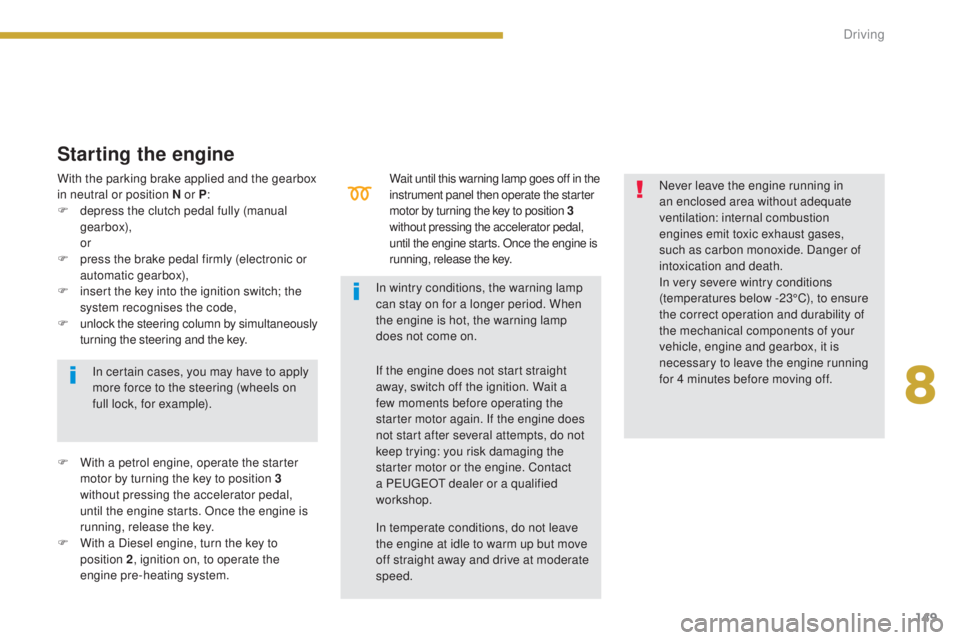
149
5008_en_Chap08_conduite_ed01-2015
Wait until this warning lamp goes off in the
instrument panel then operate the starter
motor by turning the key to position 3
without pressing the accelerator pedal,
until the engine starts. Once the engine is
running, release the key.
Starting the engine
In certain cases, you may have to apply
more force to the steering (wheels on
full lock, for example).
F
W
ith a petrol engine, operate the starter
motor by turning the key to position 3
without pressing the accelerator pedal,
until the engine starts. Once the engine is
running, release the key.
F
W
ith a Diesel engine, turn the key to
position 2 , ignition on, to operate the
engine pre-heating system. Never leave the engine running in
an enclosed area without adequate
ventilation: internal combustion
engines emit toxic exhaust gases,
such as carbon monoxide. Danger of
intoxication and death.
In very severe wintry conditions
(temperatures below -23°C), to ensure
the correct operation and durability of
the mechanical components of your
vehicle, engine and gearbox, it is
necessary to leave the engine running
for 4 minutes before moving off.
In wintry conditions, the warning lamp
can stay on for a longer period. When
the engine is hot, the warning lamp
does not come on.
With the parking brake applied and the gearbox
in neutral or position N or P
:
F
d
epress the clutch pedal fully (manual
gearbox),
or
F
p
ress the brake pedal firmly (electronic or
automatic gearbox),
F
i
nsert the key into the ignition switch; the
system recognises the code,
F
u
nlock the steering column by simultaneously
turning the steering and the key.
If the engine does not start straight
away, switch off the ignition. Wait a
few moments before operating the
starter motor again. If the engine does
not start after several attempts, do not
keep trying: you risk damaging the
starter motor or the engine. Contact
a PEUGEOT dealer or a qualified
workshop.
In temperate conditions, do not leave
the engine at idle to warm up but move
off straight away and drive at moderate
speed.
8
Driving
Page 152 of 364
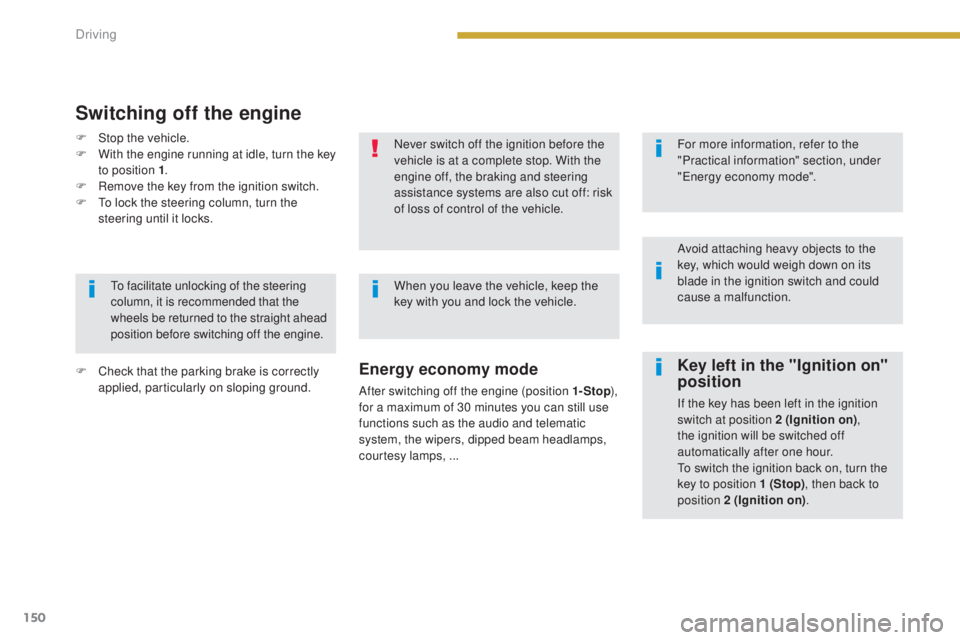
150
5008_en_Chap08_conduite_ed01-2015
Key left in the "Ignition on"
position
If the key has been left in the ignition
switch at position 2 (Ignition on),
the ignition will be switched off
automatically after one hour.
To switch the ignition back on, turn the
key to position 1 (Stop) , then back to
position 2 (Ignition on) .
Avoid attaching heavy objects to the
key, which would weigh down on its
blade in the ignition switch and could
cause a malfunction. For more information, refer to the
"Practical information" section, under
"Energy economy mode".
Switching off the engine
Energy economy mode
After switching off the engine (position 1- Stop
),
for a maximum of 30 minutes you can still use
functions such as the audio and telematic
system, the wipers, dipped beam headlamps,
courtesy lamps, ...
To facilitate unlocking of the steering
column, it is recommended that the
wheels be returned to the straight ahead
position before switching off the engine.
F
C
heck that the parking brake is correctly
applied, particularly on sloping ground. Never switch off the ignition before the
vehicle is at a complete stop. With the
engine off, the braking and steering
assistance systems are also cut off: risk
of loss of control of the vehicle.
When you leave the vehicle, keep the
key with you and lock the vehicle.
F
S
top the vehicle.
F
W
ith the engine running at idle, turn the key
to position 1 .
F
R
emove the key from the ignition switch.
F
T
o lock the steering column, turn the
steering until it locks.
Driving
Page 153 of 364
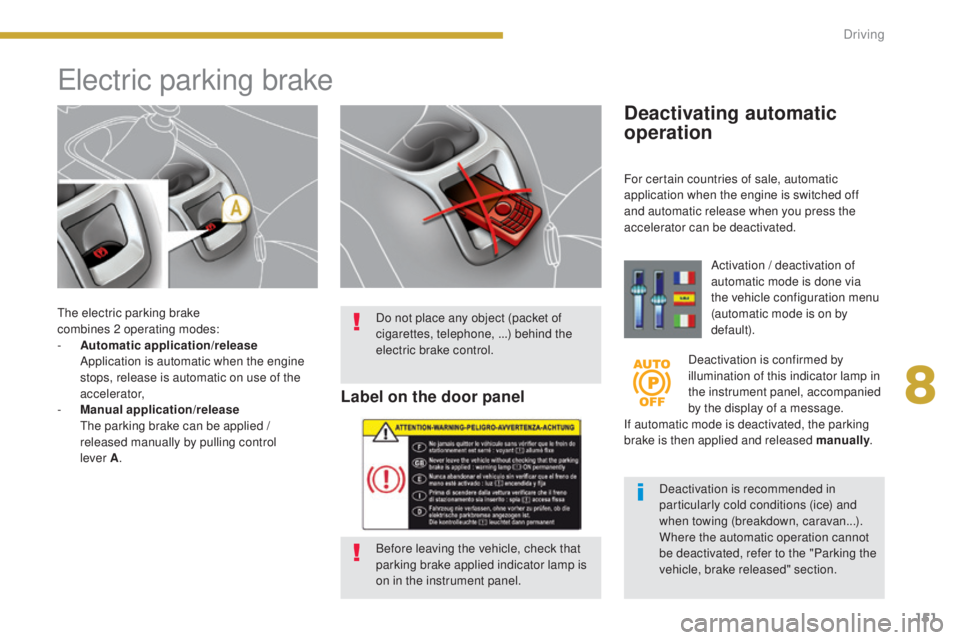
151
5008_en_Chap08_conduite_ed01-2015
The electric parking brake
combines 2 operating modes:
-
A
utomatic application/release
A
pplication is automatic when the engine
stops, release is automatic on use of the
accelerator,
-
M
anual application/release
T
he parking brake can be applied /
released manually by pulling control
lever
A.
Electric parking brake
Deactivating automatic
operation
Activation / deactivation of
automatic mode is done via
the vehicle configuration menu
(automatic mode is on by
default).
Deactivation is confirmed by
illumination of this indicator lamp in
the instrument panel, accompanied
by the display of a message.
If automatic mode is deactivated, the parking
brake is then applied and released manually .
Deactivation is recommended in
particularly cold conditions (ice) and
when towing (breakdown, caravan...).
Where the automatic operation cannot
be deactivated, refer to the "Parking the
vehicle, brake released" section.
For certain countries of sale, automatic
application when the engine is switched off
and automatic release when you press the
accelerator can be deactivated.
Label on the door panel
Before leaving the vehicle, check that
parking brake applied indicator lamp is
on in the instrument panel. Do not place any object (packet of
cigarettes, telephone, ...) behind the
electric brake control.
8
Driving
Page 167 of 364
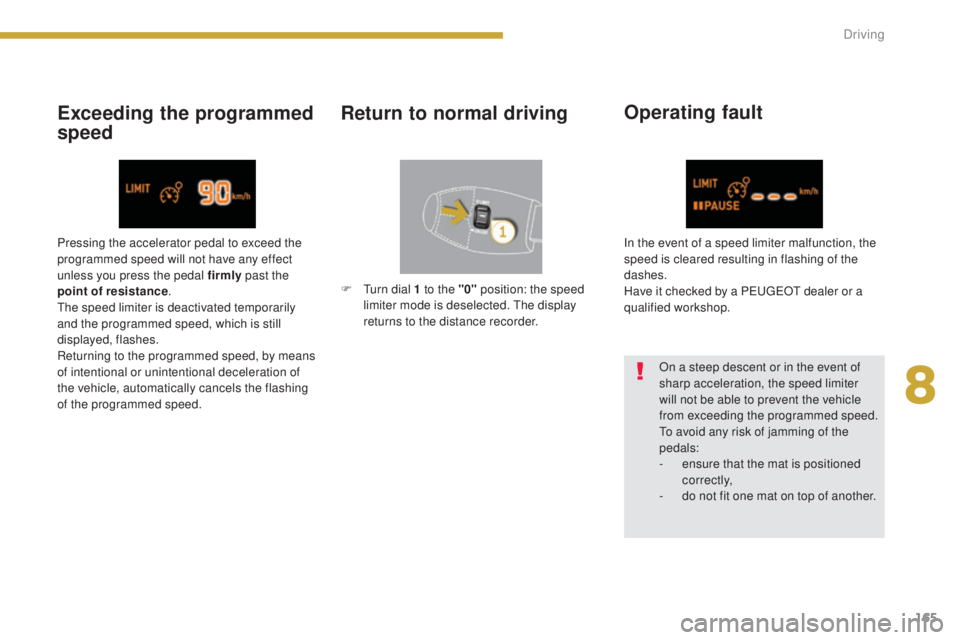
165
5008_en_Chap08_conduite_ed01-2015
Exceeding the programmed
speedReturn to normal driving
Operating fault
On a steep descent or in the event of
sharp acceleration, the speed limiter
will not be able to prevent the vehicle
from exceeding the programmed speed.
To avoid any risk of jamming of the
pedals:
-
e
nsure that the mat is positioned
c o r r e c t l y,
-
d
o not fit one mat on top of another.
Pressing the accelerator pedal to exceed the
programmed speed will not have any effect
unless you press the pedal firmly
past the
point of resistance .
The speed limiter is deactivated temporarily
and the programmed speed, which is still
displayed, flashes.
Returning to the programmed speed, by means
of intentional or unintentional deceleration of
the vehicle, automatically cancels the flashing
of the programmed speed. In the event of a speed limiter malfunction, the
speed is cleared resulting in flashing of the
dashes.
Have it checked by a PEUGEOT dealer or a
qualified workshop.
F
T
urn dial 1 to the "0"
position: the speed
limiter mode is deselected. The display
returns to the distance recorder.
8
Driving
Page 168 of 364
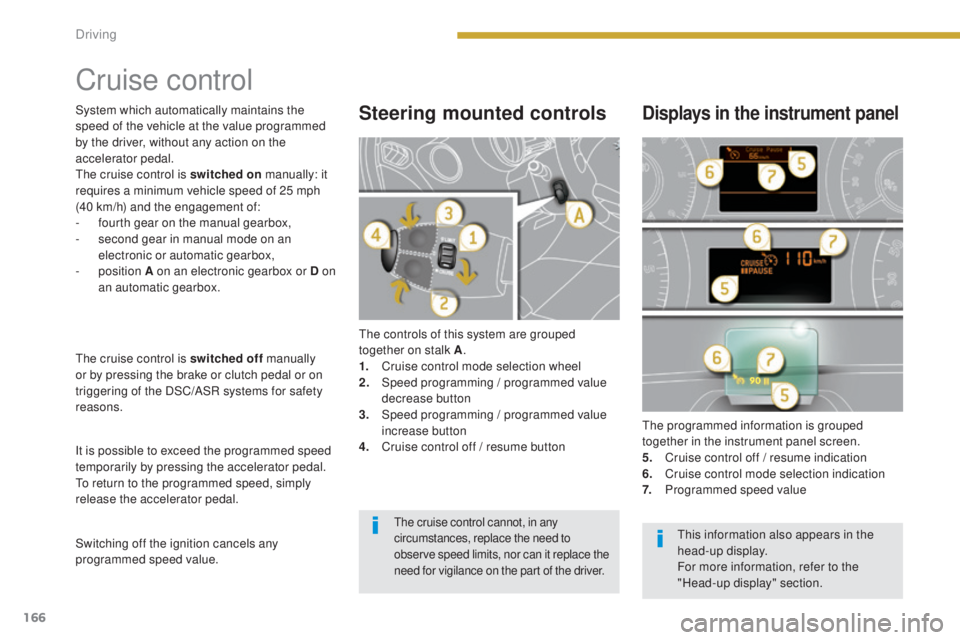
166
5008_en_Chap08_conduite_ed01-2015
Cruise control
The controls of this system are grouped
together on stalk A.
1.
C
ruise control mode selection wheel
2.
S
peed programming / programmed value
decrease button
3.
S
peed programming / programmed value
increase button
4.
C
ruise control off / resume button The programmed information is grouped
together in the instrument panel screen.
5.
C
ruise control off / resume indication
6.
C
ruise control mode selection indication
7.
P
rogrammed speed value
Steering mounted controlsDisplays in the instrument panel
The cruise control is switched off manually
or by pressing the brake or clutch pedal or on
triggering of the DSC/ASR systems for safety
reasons.
It is possible to exceed the programmed speed
temporarily by pressing the accelerator pedal.
To return to the programmed speed, simply
release the accelerator pedal.
Switching off the ignition cancels any
programmed speed value. System which automatically maintains the
speed of the vehicle at the value programmed
by the driver, without any action on the
accelerator pedal.
The cruise control is switched on manually: it
requires a minimum vehicle speed of 25 mph
(40 km/h) and the engagement of:
-
f
ourth gear on the manual gearbox,
-
s
econd gear in manual mode on an
electronic or automatic gearbox,
- position
A on an electronic gearbox or D on
an automatic gearbox.
The cruise control cannot, in any
circumstances, replace the need to
observe speed limits, nor can it replace the
need for vigilance on the part of the driver.This information also appears in the
head-up display.
For more information, refer to the
"Head-up display" section.
Driving